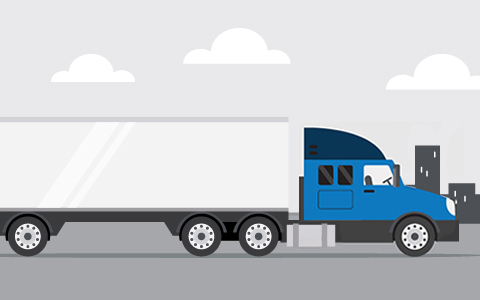How to Profitably Grow Your Trucking Business: 5 Ways to Work Smarter


Trucking business owners know their industry is fast-moving and demanding. To grow a trucking business, you need to be well-informed on pricing, hiring practices and industry trends. Add in the challenges of rapid delivery, fluctuating fuel costs and inflationary pressures, and the need to be efficient and strategic becomes more critical.
To be competitive, look for ways to work smarter. Think about strategic ways you can leverage your fleet. Then, focus on the trucking business opportunities that will help you keep your business strong and profitable. Consider the following tips:
1. Consider your load management options
Load management is a key consideration for any trucking business. Profitability often flows through loaded miles. That starts with understanding your revenue per mile.1
To improve your trucking company profit margins, look for ways to reduce deadhead miles—the return leg of a trip after the cargo has been delivered and the trailer is empty. Deadhead miles are one place to begin to improve your margins.2 Consider reducing the average length of hauls and finding backhaul opportunities where you can. This may be more feasible than ever, as the e-commerce boom has led to an increase in warehouse and distribution centers located closer to cities and higher population areas.3
Here are some suggestions for exploring new trucking business opportunities:
- Review route options: There may be opportunities for new routes that serve your location. Learn about distribution centers that are growing by communicating with local big box retailers, following warehouse builds in your region, or through plain old-fashioned word of mouth conversations.4 Establishing routes near high-growth areas can help reduce deadhead miles and overall transportation spending while improving revenue per mile and decreasing wear and tear on your equipment.
- Review load boards: Paid services such as load boards are good sources of information. They provide details on loads posted by shippers, manufacturers and brokers.5 You may also be able to use these boards to find backhauls, helping you to lower deadhead miles.
2. Optimize your fuel costs
Fluctuating fuel costs also present a challenge for trucking fleet owners trying to grow their business. Because fuel rates are part of the total cost of shipping, when fuel prices fluctuate, they impact the cost of shipping goods.6
While you don’t have control over diesel prices, you can take steps to help improve efficiency in your trucking business, so those increases don’t eat as much into your bottom line.
Consider the following strategies to help reduce fuel consumption:
- Fuel cards: Fuel cards offer discounted gas prices at a network of fueling stations across the country. Many large truck-stop chains offer programs, but you may be able to negotiate deals with local fuel vendors or work with a mobile fueling service.7 Explore the available options to find the best discounts and benefits for your routes.8
- Fuel tracking solutions: Paid services like fuel tracking tools can monitor onboard GPS and vehicle data, providing accurate and up-to-date fuel usage for your fleet. These can also help reduce fuel theft and identify dangerous driving behaviors.9
3. Improve your routing efficiency
Research shows proper route selection and effective driving can help improve fuel consumption,10 which helps improve your route efficiency. It’s also helpful if you can be flexible in your scheduling and receiving. For example, scheduling driving during off-peak hours can help reduce idling, saving fuel and cutting travel time.
Also, train your drivers on trucking best practices for operating and maintaining vehicles and making better route selections. Optimizing your planning for efficiency includes considering the type of freight and specific requirements, such as temperature control, as well as the best driving conditions and distribution locations.11
There are an increasing number of tools trucking companies can use to streamline the process from start to finish:
- Predictive analytics: These tools and systems use artificial intelligence to assess route and weather data to find optimal routes and opportunities for adding backhaul based on location, which can help streamline operations.12
- Tire management systems: Tire issues cause approximately half of all roadside breakdowns.13 Tools that monitor tire management can assist in streamlining tire operations, helping spot leaks and pressure issues. This can help reduce downtime and improve driving efficiency.14
4. Explore telematics-enabled tools
Part of growing a trucking company is expanding your fleet, which can mean adding new drivers and routes to manage. That’s hard to do without a system. Technology-enabled tools, such as telematics systems, make it easier to keep track of your drivers and monitor weather, speed, and routing data. These all can help improve your revenue.
Telematics use GPS and sensors on and within trucks to gather data, such as location and navigation, speed and acceleration, and fuel consumption.15 These systems coordinate with a truck’s onboard diagnostics system and transmit the data back to the fleet manager.16 A fleet manager would be able to monitor drivers and streamline performance, communication, and shipment management.17
Some ways to use telematics-based technology include:
- Driver training and coaching: Telematics can help aid the driver training process. Onboard systems that monitor distance, speed and fuel can help create a scorecard for each new driver, which helps to compare to your current baseline.
- Security: Another feature of telematics systems includes security tracking features. If a trailer or other mobile piece of equipment is stolen or goes missing, data from the tracking system can offer real-time updates to determine its location.
5. Focus on driver retention
Another pressing issue trucking fleet owners face is turnover.18 The industry has struggled with driver retention across the board in recent years, and it’s been difficult to catch up.19 Growing demands, aging drivers and commercial driving school closures and backlogs have all contributed to a shortage of available drivers.20
Driver shortages can have wide-ranging impacts across the industry, including delays, scheduling problems and lost revenue. Finding ways to attract new drivers and retain good drivers you have is another trucking business opportunity to explore.
Here are some best practices for improving retention:
- Offer driver bonuses: Bonuses help to incentivize drivers and reward good behavior. Across the industry, the three most common types are starting bonuses, retention bonuses and driver safety21
- Recognize driver preferences: Not all drivers are interested in all routes. Work with your drivers to determine their priorities and consider maximizing pay and opportunities for those who prefer long-haul versus day trips.22
Protect your trucking business with Northland Insurance®
These trucking business tips and best practices can help you stay competitive, keep your business growing and improve your revenue. But an important part of any strategy for advancing your business includes protecting it with the appropriate insurance coverage.
Learn more about industry-leading insurance products designed to address the unique risks facing trucking businesses like yours, contact Northland Insurance.
The information provided in this document is intended for use as a guideline and is not intended as, nor does it constitute, legal or professional advice. Northland Insurance does not warrant that adherence to, or compliance with, any recommendations, best practices, checklists, or guidelines will result in a particular outcome. In no event will Northland Insurance be liable in tort or in contract to anyone who has access to or uses this information for any purpose.
Sources
1https://www.freightwaves.com/news/understanding-total-operating-cost-per-mile
2https://www.freightwaves.com/news/loaded-and-rolling-shippers-empire-strikes-back-trucking-average-length-of-haul-declines3https://www.ttnews.com/articles/target-open-hubs-chicago-denver
4https://www.freightwaves.com/news/supply-chain-crisis-drives-more-retailers-to-buy-logistics-and-trucking-firms5https://www.freightwaves.com/news/fmcsa-commenters-debate-whether-load-boards-should-register-as-brokers6https://www.freightwaves.com/news/sonar-sightings-seattle-volumes-perk-up-diesel-prices-surpass-5-307,8https://www.truckinginfo.com/10173999/5-ways-a-fuel-program-can-save-your-truck-fleet-money9https://www.ttnews.com/articles/stop-internal-fuel-theft-fuel-tracking-and-analytics10https://truckingresearch.org/sustainable-driving-practices/11https://www.freightwaves.com/news/route-optimization-vs-planning-what-are-the-differences12https://www.ttnews.com/articles/advances-analytics-help-fleets-translate-information-action13,14https://www.ttnews.com/articles/goodyear-tire-management-system-complete-solution 15,16,17https://www.ttnews.com/articles/how-truckings-adoption-telematics-has-forever-changed-fleet-management18,20https://www.ttnews.com/articles/atris-annual-top-industry-issues-survey-underway19https://www.freightwaves.com/news/tips-for-boosting-driver-retention21https://truckingresearch.org/wp-content/uploads/2022/08/ATRI-Operational-Cost-of-Trucking-2022.pdf22https://www.ttnews.com/articles/private-fleets-sharpen-focus-driver-satisfaction




